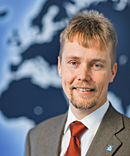Buildings can become 30% more energy efficient
Buildings are the biggest source of energy losses in our society. They consume almost half of the world’s total energy needs. This is one of the problems which leading researchers throughout the entire world are hoping to remedy when they get together at KTH for a conference week on cyber-physical systems.

Cyber-physical systems (CPS), where computer power and communication technology are built into our day-to-day activities in order to simplify and make things more efficient, is the next stage in the development of society.
“This type of system is very quickly becoming a necessary base for our entire societal infrastructure – this is in addition to energy, water and transport systems. They have the potential to contribute to future solutions as regards the world’s energy, environmental and social problems. This is where Sweden has major opportunities to be involved and lead this development,” says Karl Henrik Johansson, professor of network regulation and chairman of the conference CPS Week 2010 at KTH.
The reason is simple. If heating, lighting, ventilation and air conditioning are regulated automatically with the systems being connected together, then buildings can be made considerably more energy-efficient. The Energy Agency’s figures indicate that a reduction in energy consumption of 30% with the help of cyber-physical systems is possible in our buildings. With presence-controlled systems - heating that is regulated automatically depending on how many people are in a room – it would mean that we could save even more energy.
“In the long term, cyber-physical systems will reduce our need for fossil fuels. At the same time, these new systems will be easy to use and maintain. This is what the research about different cyber-physical systems is based on,” says Karl Henrik Johansson.
But the research on cyber-physical systems is not limited to buildings. These systems in the future will make everything from transport systems and industrial processes to smart electricity networks and home care more efficient and easier to use.
Shankar Sastry, visiting professor at the School of Electronics and Systems Technology at KTH provides an example as to how important these systems are by telling us about the future of the car.
“Traditional IT has revolutionised man’s day-to-day activities, but it is, in itself, static. You have to look for information and search for knowledge. The car on the other hand is a physically dynamic system and uses more energy than necessary because the driver does not drive his vehicle in a fuel-efficient manner, instead he creates traffic jams for example. If we are tired when we drive, it also means that we can more easily get involved in an accident. Transport systems of the future will be made both safer and more efficient for individuals and society in general,” says Shankar Sastry.
He adds that in a heavily trafficked area, these systems could make a difference by making use of information from sensors in the vehicles.
“In this way, traffic will become more energy-efficient at the same time as the flow of traffic will become more gentle and safer,” says Shankar Sastry.
The conference CPS Week 2010 about different cyber-physical systems is being organised by KTH between 12-16 April together with IEEE, the world’s biggest interest organisation for engineers and ACM, the Association for Computing Machinery.
For more information, contact Marie Androv at 08 - 790 84 13 or androv@kth.se.
Find details of the conference at www.cpsweek2010.se
Peter Larsson

